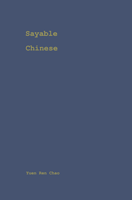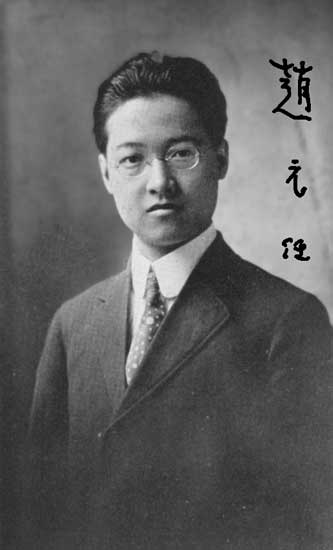 I’ve just added Y.R. Chao’s Sayable Chinese series to my list of recommended books. The second book in this series of three comprises Chao’s delightful translation of Lewis Carroll’s Through the Looking-Glass. I’ve selected part of the Humpty Dumpty chapter for the sample reading on Pinyin Info. Although the sample has romanization and English, the Sayable Chinese books have romanization and Chinese characters, presented en face. (I’ll add the Chinese characters one of these days, but they’re so much trouble to type! And scanning isn’t much of an improvement.)
I’ve just added Y.R. Chao’s Sayable Chinese series to my list of recommended books. The second book in this series of three comprises Chao’s delightful translation of Lewis Carroll’s Through the Looking-Glass. I’ve selected part of the Humpty Dumpty chapter for the sample reading on Pinyin Info. Although the sample has romanization and English, the Sayable Chinese books have romanization and Chinese characters, presented en face. (I’ll add the Chinese characters one of these days, but they’re so much trouble to type! And scanning isn’t much of an improvement.)
These hardback books are a good deal at US$15 each.
The romanization method is Chao’s own Gwoyeu Romatzyh system.
Here’s a sample, with Hanyu Pinyin for comparative purposes:
Gwoyeu RomatzyhKeesh neh jitzeel yueh jaang yueh dah, yueh jaang yueh shianq ren-yanql: Alihsy tzoou-dawle i-leang-janq luh gencheal, jiow kann.chu ta yeou yeanjing byitz tzoei lai le; ta tzay tzoou-jinn ideal jiow chingchingchuuchuu de kann.chulai ta jiowsh HUENDIH DUENDIH been-ren le. Ta duey tzyhjii shuo, “Jeh buhuey sh byeren le! Yonq.bu-jaur geei ta shieele maan-lean de mingtz woo jiow idinq jydaw sh ta le!” |
Hanyu PinyinKěshì nèi jīzǐr yuè zhǎng yuè dà, yuè zhǎng yuè xiàng rényàngr: Ālìsī zǒudào le yī liǎng zhàng lù gēnqián, jiù kànchū tā yǒu yǎnjing bízi zuǐ lái le; tā zài zǒujìn yīdiǎnr jiù qīngqingchǔchǔ de kànchūlai tā jiùshì HŪNDÌ DŪNDÌ běnrén le. Tā duì zìjǐ shuō, “Zhè bù huì shì biéren le! Yòngbuzháo gěi tā xiě le mǎnliǎn de míngzi wǒ jiù yīdìng zhīdao shì tā le!” |
EnglishHowever, the egg only got larger and larger, and more and more human: when she had come within a few yards of it, she saw that it had eyes and a nose and mouth; and when she had come close to it, she saw clearly that it was HUMPTY DUMPTY himself. “It can’t be anybody else!” she said to herself. “I’m as certain of it, as if his name were written all over his face.” |
Chinese characters可是那雞子兒越長越大,越長越象人樣兒:阿麗思走到了一兩丈路跟前,就看出它有眼睛鼻子嘴來了;她再走近一點兒就清清楚楚的看出來它就是昏弟敦弟本人了。她對自己說,“這不會是別人了!用不著給他寫了滿臉的名字我就一定知道是他了!” |
Recordings of all of the books in the Sayable Chinese series are available on cassette. The recordings were made by Chao and his family. Unfortunately, I don’t have any of these — they’re expensive! — so I can’t supply a sound file for the section above. The Folkways recording of Chao’s Mandarin Primer, however, has a 30-second excerpt from from the Tweedledum and Tweedledee section. Here’s the English version of what’s being said:

Tweedledee: You like poetry?
Alice: Ye-es, pretty well — some poetry. Would you tell me which road leads out of the wood?
Tweedledee: What shall I repeat to her? “The Walrus and the Carpenter” is the longest.
The sun was shining—Alice: If it’s very long, would you tell me first which road —
Tweedledee:
The sun was shining—
I think that’s Chao’s daughter, Rulan Chao Pian, as Alice, and Chao as Tweedledee.
Book Three contains Chao’s adaptation of The Mollusc, a 1908 stage comedy by H. H. Davies. (Alas, Project Gutenberg doesn’t have the text of this yet.) Interestingly, this play has an association with another romanization-related figure, Harold E. Palmer, who published The Principles of Romanization in 1930 and who was a leading figure in the field of English teaching. Palmer’s daughter Dorothee published an “annotated phonetic edition” (complete with tone marks) of The Mollusc in 1929. (Palmer had taught her how to read and write in phonetic notation, leaving her to pick up traditional spelling on her own!)
Pinyin Info also has the text of Y.R. Chao’s much-misunderstood stone lions story. Chao was making a point about Classical Chinese, not modern Mandarin. As the architect of a romanization system, Chao understood perfectly well that Mandarin is not doomed to a hell of homophony without Chinese characters.

It should be “yue zhang yue da”, not “yue chang yue da”. The meaning of the ? character here is “grow” as opposed to “length”.
You’re quite right. Thanks! It’s fixed now.
Imagine using this text as the primary text in 3rd year Chinese at University, with a teacher who couldn’t really teach. We just read through the text, in order, day after day. You might find it inviting, but I’m still shaking my head.